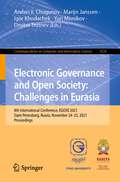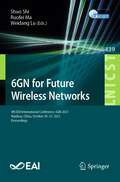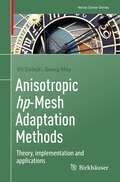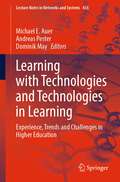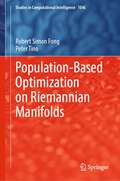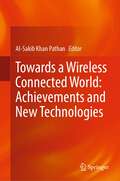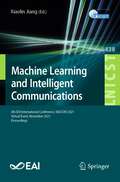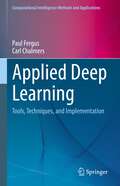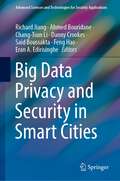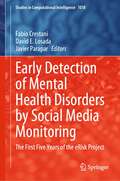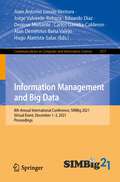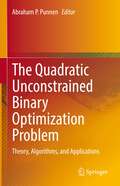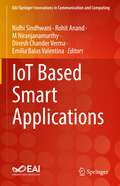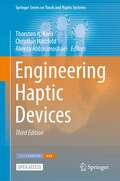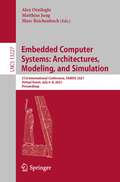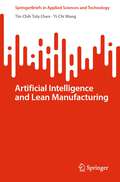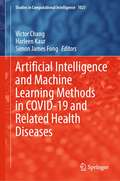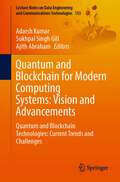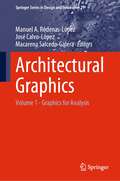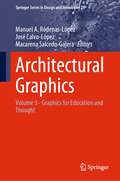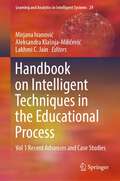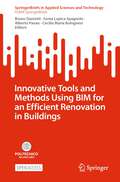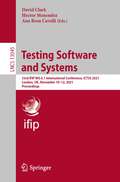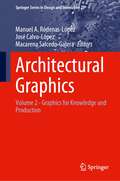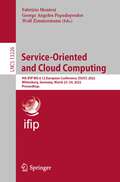- Table View
- List View
Electronic Governance and Open Society: 8th International Conference, EGOSE 2021, Saint Petersburg, Russia, November 24–25, 2021, Proceedings (Communications in Computer and Information Science #1529)
by Andrei V. Chugunov Marijn Janssen Igor Khodachek Yuri Misnikov Dmitrii TrutnevThis book constitutes the refereed proceedings of the 8th Conference on Electronic Governance and Open Society: Challenges in Eurasia, EGOSE 2021, held in St. Petersburg, Russia, in November 2021.The 21 full papers were carefully reviewed and selected from 69 submissions, additionally one invited paper has been included in this volume. The papers are organized in topical sections on digital technology and design; digital Society; digital government and economy.
6GN for Future Wireless Networks: 4th EAI International Conference, 6GN 2021, Huizhou, China, October 30–31, 2021, Proceedings (Lecture Notes of the Institute for Computer Sciences, Social Informatics and Telecommunications Engineering #439)
by Shuo Shi Ruofei Ma Weidang LuThis book constitutes the proceedings of the 4th International Conference on 6G for Future Wireless Networks, 6GN 2021, held in Huizhou, China, in October 2021. The 63 full papers were selected from 136 submissions and present the state of the art and practical applications of 6G technologies. The papers are arranged thematically in tracks as follows: Advanced Communication and Networking Technologies for 5G/6G Networks; Advanced Signal Processing Technologies for 5G/6G Networks; and Educational Changes in The Age of 5G/6G.
Anisotropic hp-Mesh Adaptation Methods: Theory, implementation and applications (Nečas Center Series)
by Vít Dolejší Georg MayMesh adaptation methods can have a profound impact on the numerical solution of partial differential equations. If devised and implemented properly, adaptation significantly reduces the size of the algebraic systems resulting from the discretization, while ensuring that applicable error tolerances are met. In this monograph, drawing from many years of experience, the authors give a comprehensive presentation of metric-based anisotropic hp-mesh adaptation methods.A large part of this monograph is devoted to the derivation of computable interpolation error estimates on simplicial meshes, which take into account the geometry of mesh elements as well as the anisotropic features of the interpolated function. These estimates are then used for the optimization of corresponding finite element spaces in a variety of settings. Both steady and time dependent problems are treated, as well as goal-oriented adaptation. Practical aspects of implementation are also explored, including several algorithms. Many numerical experiments using the discontinuous Galerkin method are presented to illustrate the performance of the adaptive techniques.This monograph is intended for scientists and researchers, including doctoral and master-level students. Portions of the text can also be used as study material for advanced university lectures concerning a posteriori error analysis and mesh adaptation.
Learning with Technologies and Technologies in Learning: Experience, Trends and Challenges in Higher Education (Lecture Notes in Networks and Systems #456)
by Michael E. Auer Andreas Pester Dominik MayEducation has always been one of the cornerstones for societal evolution and economic growth. We are currently witnessing a significant transformation in the development of education and especially post-secondary education.The use of technology impacts the way educational content is presented and acquired in many areas. The designs of immersive educational worlds and the combination of rational and emotional educational experiences that cannot be designed in the same way in the traditional classroom will come increasingly into focus.Seen in this way the book also contributes to generalize the experience of the COVID-19 crisis and its impact to quality of learning and education.Scientifically based statements as well as excellent experiences (best practice) are necessary. This book contains scientific papers in the fields of: The future of learning Eruptive technologies in learningPedagogy of online learning Deep learning vs machine learning: opportunities and challengesReimagining and rapid transition of learningInterested readership includes policymakers, academics, educators, researchers in pedagogy and learning theory, schoolteachers, learning industry, further and continuing education lecturers, etc.
Population-Based Optimization on Riemannian Manifolds (Studies in Computational Intelligence #1046)
by Robert Simon Fong Peter TinoManifold optimization is an emerging field of contemporary optimization that constructs efficient and robust algorithms by exploiting the specific geometrical structure of the search space. In our case the search space takes the form of a manifold. Manifold optimization methods mainly focus on adapting existing optimization methods from the usual “easy-to-deal-with” Euclidean search spaces to manifolds whose local geometry can be defined e.g. by a Riemannian structure. In this way the form of the adapted algorithms can stay unchanged. However, to accommodate the adaptation process, assumptions on the search space manifold often have to be made. In addition, the computations and estimations are confined by the local geometry.This book presents a framework for population-based optimization on Riemannian manifolds that overcomes both the constraints of locality and additional assumptions. Multi-modal, black-box manifold optimization problems on Riemannian manifolds can be tackled using zero-order stochastic optimization methods from a geometrical perspective, utilizing both the statistical geometry of the decision space and Riemannian geometry of the search space.This monograph presents in a self-contained manner both theoretical and empirical aspects of stochastic population-based optimization on abstract Riemannian manifolds.
Towards a Wireless Connected World: Achievements and New Technologies
by Al-Sakib Khan PathanThis book gathers key advances in various areas related to using wireless Internet and wireless connectivity to achieve a more connected world.The world is now highly dependent on Internet connectivity. Even though some parts of the globe remain isolated, the smoothly running world all around us relies on Internet services for countless businesses and activities. During the COVID-19 pandemic, we have seen that exclusively relying on wired Internet would leave out a large part of our tech-savvy world. Hence, wireless connectivity is essential to anywhere, anytime connectivity. Further, in the event of a new pandemic or other disaster of global scale, wireless Internet offers a reliable way to keep us all connected. The contributors to this book, hailing from academia, industrial and research laboratories, report on the latest solutions, trends and technologies with the potential to make wireless Internet more reliable and secure for the years to come.
Machine Learning and Intelligent Communications: 6th EAI International Conference, MLICOM 2021, Virtual Event, November 2021, Proceedings (Lecture Notes of the Institute for Computer Sciences, Social Informatics and Telecommunications Engineering #438)
by Xiaolin JiangThis volume constitutes the refereed post-conference proceedings of the 6th International Conference on Machine Learning and Intelligent Communications, MLICOM 2021, held in November 2021. Due to COVID-19 pandemic the conference was held virtually. The 28 revised full papers were carefully selected from 58 submissions. The papers are organized thematically in tracks as follows: internet of vehicle communication system; applications of neural network and deep learning; intelligent massive MIMO communications; intelligent positioning and navigation systems; intelligent space and terrestrial integrated networks; machine learning algorithms and intelligent networks; image information processing.
Applied Deep Learning: Tools, Techniques, and Implementation (Computational Intelligence Methods and Applications)
by Paul Fergus Carl ChalmersThis book focuses on the applied aspects of artificial intelligence using enterprise frameworks and technologies. The book is applied in nature and will equip the reader with the necessary skills and understanding for delivering enterprise ML technologies. It will be valuable for undergraduate and postgraduate students in subjects such as artificial intelligence and data science, and also for industrial practitioners engaged with data analytics and machine learning tasks. The book covers all of the key conceptual aspects of the field and provides a foundation for all interested parties to develop their own artificial intelligence applications.
Big Data Privacy and Security in Smart Cities (Advanced Sciences and Technologies for Security Applications)
by Richard Jiang Ahmed Bouridane Chang-Tsun Li Danny Crookes Said Boussakta Feng Hao Eran A. EdirisingheThis book highlights recent advances in smart cities technologies, with a focus on new technologies such as biometrics, blockchains, data encryption, data mining, machine learning, deep learning, cloud security, and mobile security. During the past five years, digital cities have been emerging as a technology reality that will come to dominate the usual life of people, in either developed or developing countries. Particularly, with big data issues from smart cities, privacy and security have been a widely concerned matter due to its relevance and sensitivity extensively present in cybersecurity, healthcare, medical service, e-commercial, e-governance, mobile banking, e-finance, digital twins, and so on. These new topics rises up with the era of smart cities and mostly associate with public sectors, which are vital to the modern life of people. This volume summarizes the recent advances in addressing the challenges on big data privacy and security in smart cities and points out the future research direction around this new challenging topic.
Early Detection of Mental Health Disorders by Social Media Monitoring: The First Five Years of the eRisk Project (Studies in Computational Intelligence #1018)
by Fabio Crestani David E. Losada Javier ParapareRisk stands for Early Risk Prediction on the Internet. It is concerned with the exploration of techniques for the early detection of mental health disorders which manifest in the way people write and communicate on the internet, in particular in user generated content (e.g. Facebook, Twitter, or other social media).Early detection technologies can be employed in several different areas but particularly in those related to health and safety. For instance, early alerts could be sent when the writing of a teenager starts showing increasing signs of depression, or when a social media user starts showing suicidal inclinations, or again when a potential offender starts publishing antisocial threats on a blog, forum or social network. eRisk has been the pioneer of a new interdisciplinary area of research that is potentially applicable to a wide variety of situations, problems and personal profiles.This book presents the best results of the first five years of the eRisk project which started in 2017 and developed into one of the most successful track of CLEF, the Conference and Lab of the Evaluation Forum.
Information Management and Big Data: 8th Annual International Conference, SIMBig 2021, Virtual Event, December 1–3, 2021, Proceedings (Communications in Computer and Information Science #1577)
by Juan Antonio Lossio-Ventura Jorge Valverde-Rebaza Eduardo Díaz Denisse Muñante Carlos Gavidia-Calderon Alan Demétrius Baria Valejo Hugo Alatrista-SalasThis book constitutes the refereed proceedings of the 8th International Conference on Information Management and Big Data, SIMBig 2021, held as a virtual event in December 2021. The 25 revised full papers and 2 revised short papers presented were carefully reviewed and selected from 67 submissions. The papers are organized in topical sections on data mining and applications; deep learning and applications; data-driven software engineering; health, NLP, and social media; image processing, machine learning, and semantic web.
The Quadratic Unconstrained Binary Optimization Problem: Theory, Algorithms, and Applications
by Abraham P. PunnenThe quadratic binary optimization problem (QUBO) is a versatile combinatorial optimization model with a variety of applications and rich theoretical properties. Application areas of the model include finance, cluster analysis, traffic management, machine scheduling, VLSI physical design, physics, quantum computing, engineering, and medicine. In addition, various mathematical optimization models can be reformulated as a QUBO, including the resource constrained assignment problem, set partitioning problem, maximum cut problem, quadratic assignment problem, the bipartite unconstrained binary optimization problem, among others.This book presents a systematic development of theory, algorithms, and applications of QUBO. It offers a comprehensive treatment of QUBO from various viewpoints, including a historical introduction along with an in-depth discussion of applications modelling, complexity and polynomially solvable special cases, exact and heuristic algorithms, analysis of approximation algorithms, metaheuristics, polyhedral structure, probabilistic analysis, persistencies, and related topics. Available software for solving QUBO is also introduced, including public domain, commercial, as well as quantum computing based codes.
IoT Based Smart Applications (EAI/Springer Innovations in Communication and Computing)
by Nidhi Sindhwani Rohit Anand M Niranjanamurthy Dinesh Chander Verma Emilia Balas ValentinaThis book provides insights into IoT, its applications, and various implementation techniques. The authors first discuss the IoT design methodology to define the domain model. They then cover various connection methodologies used in IoT such as Ethernet, Wi-Fi, low powered wide area network (LPWAN), Bluetooth, RFID, cellular, and satellite, and more, along with their challenges. An example is made on the designing process using Arduino, which offers smart, connected, and secure elements; they also illustrate the integration of IoT with Blockchain, cloud, machine learning, big data, embedded software, sensors, etc. The book going on to cover the future of IoT in various sectors and how IoT will continue to be game-changing technology.
Engineering Haptic Devices: A Beginner's Guide (Springer Series on Touch and Haptic Systems)
by Thorsten A. Kern Christian Hatzfeld Alireza AbbasimoshaeiThis is an open access book.In this third edition of Engineering Haptic Devices the software part was rewritten from scratch and now includes even more details on tactile and texture interaction modalities. The kinematics section was improved to extend beyond a pure knowledge explanation to a comprehensive guideline on how to actually do and implement haptic kinematic functions. The control section was reworked incorporating some hands-on experience on control implementation on haptic systems. The system, actuator and sensor design chapters were updated to allow easier access to the content.This book is written for students and engineers faced with the development of a task-specific haptic system. Now 14 years after its first edition, it is still a reference for the basics of haptic interaction and existing haptic systems and methods as well as an excellent source of information for technical questions arising in the design process of systems and components. Following a system engineering approach, it is divided into two parts with Part I containing background and reference information as a knowledge basis. Typical application areas of haptic systems and a thorough analysis of haptics as an interaction modality are introduced. The role of users in the design of haptic systems is discussed and relevant design and development stages are outlined. Part II presents all related challenges in the design of haptic systems including general system architecture and control structures, kinematics, actuator principles and all types of sensors you may encounter doing haptic device development. Beside these hardware and mechanical topics, further chapters examine state-of-the-art interfaces to operate the devices, and hardware and software development to push haptic systems to their limits.
Embedded Computer Systems: 21st International Conference, SAMOS 2021, Virtual Event, July 4–8, 2021, Proceedings (Lecture Notes in Computer Science #13227)
by Alex Orailoglu Matthias Jung Marc ReichenbachThis book constitutes the proceedings of the 21st International Conference on Embedded Computer Systems: Architectures, Modeling, and Simulation, SAMOS 2021, which took place in July 2021. Due to COVID-19 pandemic the conference was held virtually. The 17 full papers presented in this volume were carefully reviewed and selected from 45 submissions. The papers are organized in topics as follows: simulation and design space exploration; the 3Cs - Cache, Cluster and Cloud; heterogeneous SoC; novel CPU architectures and applications; dataflow; innovative architectures and tools for security; next generation computing; insights from negative results.
Artificial Intelligence and Lean Manufacturing (SpringerBriefs in Applied Sciences and Technology)
by Tin-Chih Toly Chen Yi-Chi WangThis book applies artificial intelligence to lean production and shows how to practically combine the advantages of these two disciplines. Lean manufacturing originated in Japan and is a well-known tool for improving manufacturers' competitiveness. Prevalent tools for lean manufacturing include Kanban, Pacemaker, Value Stream Map, 5s, Just-in-Time and Pull Manufacturing. Lean Manufacturing and the Toyota Manufacturing System has been successfully applied to various factories and supply chains around the world. A lean manufacturing system can not only reduce wastes and inventory, but also respond to customer needs more immediately. Artificial intelligence is a subject that has attracted much attention recently. Many researchers and practical developers are working hard to apply artificial intelligence to our daily lives, including in factories. For example, fuzzy rules have been established to optimize machine settings. Bionic algorithms have been proposed to solve production sequencing and scheduling problems. Machine learning technologies are applied to detect possible product quality problems and diagnose the health of a machine. This book will be of interest to production engineers, managers, as well as students and researchers in manufacturing engineering.
Artificial Intelligence and Machine Learning Methods in COVID-19 and Related Health Diseases (Studies in Computational Intelligence #1023)
by Victor Chang Harleen Kaur Simon James FongThis Springer book provides a perfect platform to submit chapters that discuss the prospective developments and innovative ideas in artificial intelligence and machine learning techniques in the diagnosis of COVID-19. COVID-19 is a huge challenge to humanity and the medical sciences. So far as of today, we have been unable to find a medical solution (Vaccine). However, globally, we are still managing the use of technology for our work, communications, analytics, and predictions with the use of advancement in data science, communication technologies (5G & Internet), and AI. Therefore, we might be able to continue and live safely with the use of research in advancements in data science, AI, machine learning, mobile apps, etc., until we can find a medical solution such as a vaccine. We have selected eleven chapters after the vigorous review process. Each chapter has demonstrated the research contributions and research novelty. Each group of authors must fulfill strict requirements.
Quantum and Blockchain for Modern Computing Systems: Quantum and Blockchain Technologies: Current Trends and Challenges (Lecture Notes on Data Engineering and Communications Technologies #133)
by Adarsh Kumar Sukhpal Singh Gill Ajith AbrahamThis book states that blockchain technology provides a secure distributed, peer-to-peer, and decentralized network with advanced cryptography primitives and protocols. The important question that arises in the quantum computing world is to test the existing blockchain networks against quantum attacks and design quantum computing enabled secure blockchain solutions. This book encourages professionals from different fields to provide blockchain and quantum technology-integrated solutions that incorporate low-cost, effective QoS, fast, secure, and futuristic demands. This book has surveyed and proposed approaches that improve quantum computing and cryptography protocols. Quantum computing and quantum science are not just helpful in software but the hardware world as well. To design networks with quantum science, quantum-enabled devices like quantum memories and quantum repeaters can be useful to demonstrate for organizations. For example, designing a single quantum repeater for long-distance quantum communication is useful in reducing the network cost, and ensuring better security levels. This book has introduced the quantum computing and blockchain technology aspects, their integration approaches and future directions.
Architectural Graphics: Volume 1 - Graphics for Analysis (Springer Series in Design and Innovation #21)
by Manuel A. Ródenas-López José Calvo-López Macarena Salcedo-GaleraThis book reports on several advances in architectural graphics, with a special emphasis on education, training, and research. It gathers a selection of contributions to the 19th International Conference on Graphic Design in Architecture, EGA 2022, held on June 2–4, 2022, in Cartagena, Spain, with the motto: "Beyond drawings. The use of architectural graphics".
Architectural Graphics: Volume 3 - Graphics for Education and Thought (Springer Series in Design and Innovation #23)
by José Calvo-López Manuel A. Ródenas-López Macarena Salcedo-GaleraThis book reports on several advances in architectural graphics, with a special emphasis on education, training and research. It gathers a selection of contributions to the 19th International Conference on Graphic Design in Architecture, EGA 2022, held on June 2–4, 2022, in Cartagena, Spain, with the motto: "Beyond drawings. The use of architectural graphics".
Handbook on Intelligent Techniques in the Educational Process: Vol 1 Recent Advances and Case Studies (Learning and Analytics in Intelligent Systems #29)
by Mirjana Ivanović Aleksandra Klašnja-Milićević Lakhmi C. JainEducation has a substantial impact and influences on almost all sectors in modern society. Different computer-supported educational systems have been developing for many decades to support and make easier teaching and learning processes on all levels of education. Influences of rapid development of Information Communication Technologies and other related disciplines on design and implementation of intelligent, sophisticated educational systems are evident. Nowadays intensive development and wide applications of Artificial Intelligent techniques significantly affect the development of intelligent tutoring systems, smart learning environments that incorporate virtual and augmented reality and robots.Artificial Intelligence has the potential to address some of the biggest challenges in education today, but also in the future in order to establish innovative teaching and learning practices facilitated by powerful educational datamining and learning analytics.This book presents a collection of 17 chapters that bring interesting aspects of the state-of-the-art of application of intelligent techniques in different educational processes and settings. We believe that the works presented in the book will be of great interest to readers and that will motivate them to try to enhance presented approaches and propose better and more advanced solutions.
Innovative Tools and Methods Using BIM for an Efficient Renovation in Buildings (SpringerBriefs in Applied Sciences and Technology)
by Bruno Daniotti Sonia Lupica Spagnolo Alberto Pavan Cecilia Maria BolognesiThis open access book describes a BIM-based toolkit that has been developed according to the latest research activities on building information modelling and semantic interoperability to optimize the building process. It highlights the impacts of using such new tools to fast renovation activities starting from the decision-making and design stages to the construction site management with the possibility to monitor occupants' and owners’ feedback during the realization process. In this process, a framework has been developed and implemented to allow stakeholders involved in a renovation project to efficiently compile, maintain, and add data about (i) building elements, (ii) building services systems, (iii) tenants, operators, and owners of the building, and (iv) current and predicted performance of the building from the various data sources available. The framework applies and specializes the existing practices in the Semantic Web, Linked Data, and ontology domain to the management of renovation projects. It has been designed to be open so that any system which implements the required functions and uses the specified conventions will be able to achieve semantic interoperability with other framework-compliant systems in the renovation domain. Finally, this book represents the validation process of the toolkit that has been held in three demo sites: a social housing building in Italy and two private residential buildings in Poland and Finland. The outcome shows that the toolkit facilitates the renovation process with relevant reductions of time, costs, and energy consumption and that the inhabitants can take advantage of the increase in building performances, quality, and comfort.
Testing Software and Systems: 33rd IFIP WG 6.1 International Conference, ICTSS 2021, London, UK, November 10–12, 2021, Proceedings (Lecture Notes in Computer Science #13045)
by David Clark Hector Menendez Ana Rosa CavalliThis book constitutes the refereed proceedings of the 33rd IFIP WG 6.1 International Conference on Testing Software and Systems, ICTSS 2021, which was supposed to be held in London, UK, but was held virtually due to the COVID-19 pandemic. The 10 regular papers and 7 short papers presented were carefully reviewed and selected from 36 submissions. Additionally, the volume includes 6 project reports. The papers are divided into the following topical subheadings: Finite State Machine-based Testing; Test Generation and Selection; AI-based Techniques; Use Cases; Project Reports.
Architectural Graphics: Volume 2 - Graphics for Knowledge and Production (Springer Series in Design and Innovation #22)
by Manuel A. Ródenas-López José Calvo-López Macarena Salcedo-GaleraThis book reports on several advances in architectural graphics, with a special emphasis on education, training and research. It gathers a selection of contributions to the 19th International Conference on Graphic Design in Architecture, EGA 2022, held on June 2–4, 2022, in Cartagena, Spain, with the motto: "Beyond drawings. The use of architectural graphics".
Service-Oriented and Cloud Computing: 9th IFIP WG 6.12 European Conference, ESOCC 2022, Wittenberg, Germany, March 22–24, 2022, Proceedings (Lecture Notes in Computer Science #13226)
by Fabrizio Montesi George Angelos Papadopoulos Wolf ZimmermannThis book constitutes the refereed proceedings of the 8th IFIP WG 2.14 European Conference on Service-Oriented and Cloud Computing, ESOCC 2022, held in Wittenberg, Germany, in March 2022. The 6 full and 2 short papers presented in this volume were carefully reviewed and selected from 17 submissions.
